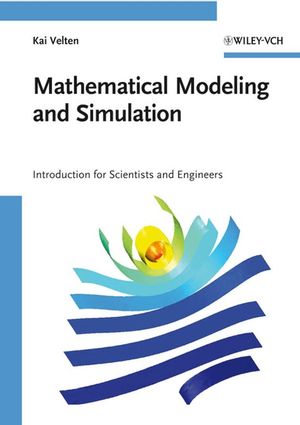Mathematical Modeling and Simulation: Introduction for Scientists and EngineersISBN: 978-3-527-40758-3
Paperback
362 pages
February 2009
 This is a Print-on-Demand title. It will be printed specifically to fill your order. Please allow an additional 10-15 days delivery time. The book is not returnable.
|
||||||
Preface
1. Principles of Mathematical Modeling
1.1 A complex world needs models
1.2 Systems, models, simulations
1.3 Mathematics is the natural modeling language
1.4 Definition of mathematical models
1.5 Examples and some more definitions
1.6 Even more definitions
1.7 Classification of mathematical models
1.8 Everything looks like a nail?
2. Phenomenological models
2.1 Elementary statistics
2.2 Linear regression
2.3 Multiple linear regression
2.4 Nonlinear regression
2.5 Neural networks
2.6 Design of experiments
2.7 Other phenomenological modeling approaches
3. Mechanistic models I: ODE's
3.1 Distinguished role of differential equations
3.2 Introductory examples
3.3 General idea of ODE's
3.4 Setting up ODE models
3.5 Some theory you should know
3.6 Solution of ODE's: Overview
3.7. Closed form solution
3.8 Numerical solutions
3.9 Fitting ODE's to data
3.10 More examples
4. Mechanistic models II: PDE's
4.1. Introduction
4.2. The heat equation
4.3. Some theory you should know
4.4 Closed form solution
4.5 Numerical solution of PDE's
4.6 The finite difference method
4.7 The finite element method
4.8 Finite element software
4.9 A sample session using Salome Meca
4.10 A look beyond the heat equation
4.11 Other mechanistic modeling approaches
A CAELinux and the book software
B R (programming language and software environment)
C Maxima
1. Principles of Mathematical Modeling
1.1 A complex world needs models
1.2 Systems, models, simulations
1.3 Mathematics is the natural modeling language
1.4 Definition of mathematical models
1.5 Examples and some more definitions
1.6 Even more definitions
1.7 Classification of mathematical models
1.8 Everything looks like a nail?
2. Phenomenological models
2.1 Elementary statistics
2.2 Linear regression
2.3 Multiple linear regression
2.4 Nonlinear regression
2.5 Neural networks
2.6 Design of experiments
2.7 Other phenomenological modeling approaches
3. Mechanistic models I: ODE's
3.1 Distinguished role of differential equations
3.2 Introductory examples
3.3 General idea of ODE's
3.4 Setting up ODE models
3.5 Some theory you should know
3.6 Solution of ODE's: Overview
3.7. Closed form solution
3.8 Numerical solutions
3.9 Fitting ODE's to data
3.10 More examples
4. Mechanistic models II: PDE's
4.1. Introduction
4.2. The heat equation
4.3. Some theory you should know
4.4 Closed form solution
4.5 Numerical solution of PDE's
4.6 The finite difference method
4.7 The finite element method
4.8 Finite element software
4.9 A sample session using Salome Meca
4.10 A look beyond the heat equation
4.11 Other mechanistic modeling approaches
A CAELinux and the book software
B R (programming language and software environment)
C Maxima



